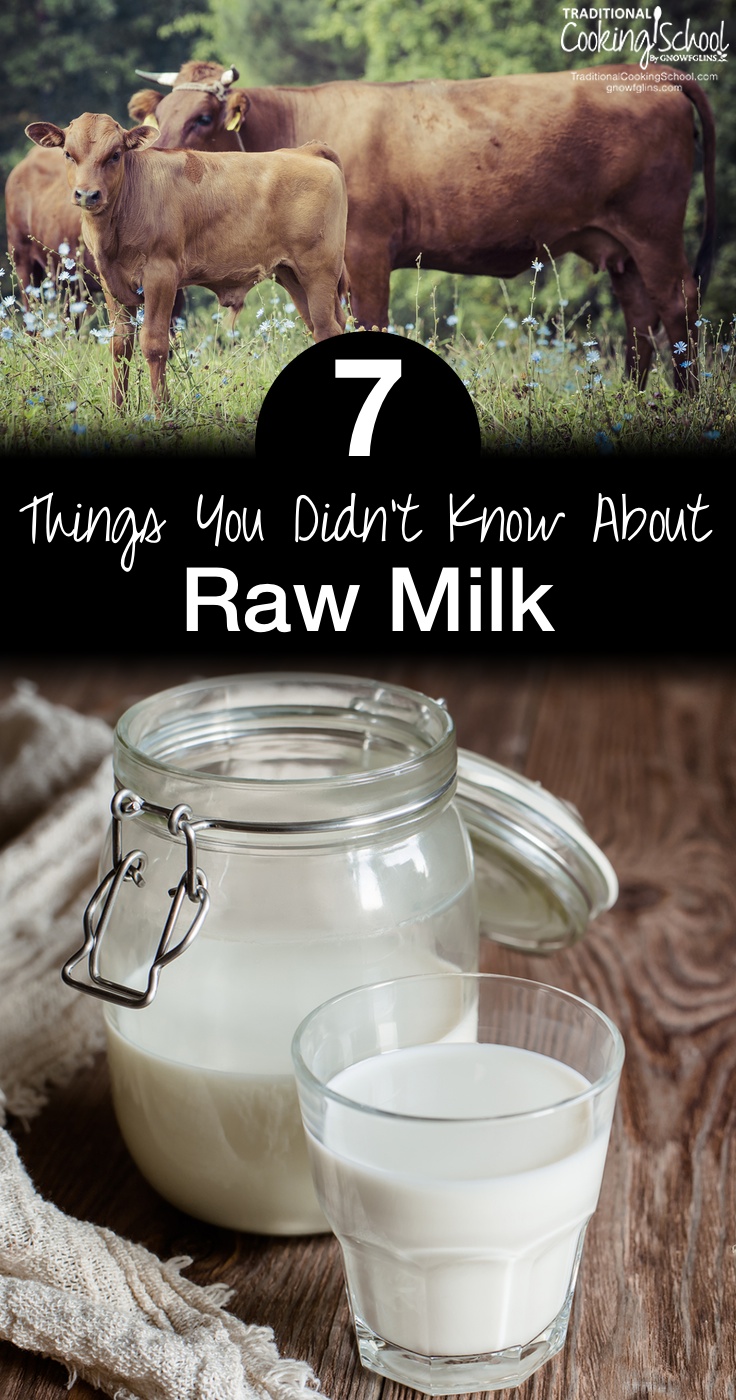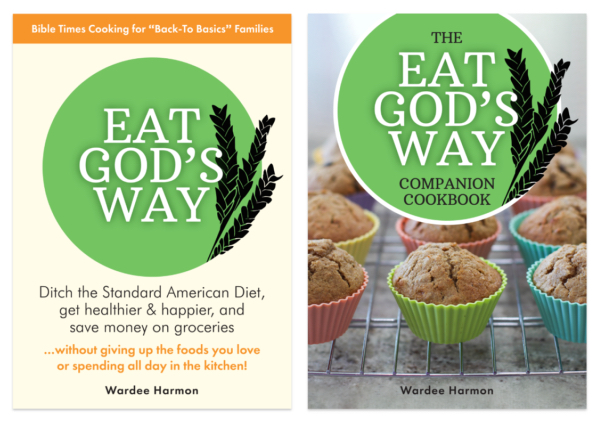
I love raw milk. Especially un-homogenized raw milk.
I love how cream rises to the top and settles in a thick, luxurious layer. I love that milk is a blank canvas — and yet a food in its own right. And, I love that it can be made into cottage cheese, yogurt, and butter, and squeaky Cheddar curds! (Big fan of those.)
I love that people like you and me can raise healthy livestock in a clean environment to produce milk that teems with living organisms.
I also love the chemistry of it. What makes the proteins in raw milk different from the rest of the food proteins? Why does cream rise to the top? What do fin whales have to do with it?
So, in this post, I want to share my excitement with you. What’s going on in your everyday glass of milk?
1. Raw Milk Is Like A Mini Food Pyramid.
Not only is it a complete protein — with all 9 of the essential amino acids — it also has fat, carbohydrates, multiple vitamins, and minerals (source).
2. Bundles And Bundles Of Casein Proteins
Behold, milk proteins. Given a fresh glass of milk, you wouldn’t even know that they existed. But you have seen them.
Ever made a block of cheese? Those are (mostly) the caseins — curdled, squeezed of water, and aged to perfection.
Chemically, caseins are bundled into aggregates called micelles, held together by calcium phosphate which acts as a sort of glue. Another casein — kappa-casein — forms a negatively-charged “hairy layer” on the surface of each individual micelle. As a result, since negatives repel negatives, micelles stay separated and evenly dispersed throughout the milk. (On Food and Cooking, page 19.)
Furthermore, caseins are special among food proteins because — given fresh milk with low acidity and salinity — they are relatively tolerant of heat. This allows them to be utilized in many dishes where other proteins (such as in eggs and meat) would curdle. (On Food and Cooking, page 19.)
Additionally, these micelles allow for the formation of cheese and yogurt as we know them.
If you’re interested in learning to make your own cultured dairy and cheese, we have a class entirely devoted to the subject, just for you! You’ll learn things like these 4 Easy Raw Cheese Recipes — the cheeses I make over and over, Basic Cheesemaking Cultures and Supplies, and the Benefits of Raw Cheese.
3. The Whey Proteins Are W(he)y Cool, Too.
Coming from someone who practically rates articles based on the level of pun achieved, maybe I shouldn’t have made that pun. 😉
You’ve probably heard of whey. It’s the liquid drained off of cheese or squeezed out of yogurt. (Learn how to use whey here.) Well, that liquid can also be home to the whey proteins — globular proteins that act both in immunity, and as enzymes.
Ever cooked milk and wondered what that smell was? Lactoglobulin, the major whey protein, denatures at 172 degrees Fahrenheit. That’s when it unfolds and exposes its sulfur atoms to the rest of the milk. Consequently, the sulfur binds with hydrogen to create hydrogen sulfide gas. And that is the cooked odor of milk. (On Food and Cooking, page 20.)
4. Cream Rises To The Top Of Milk Via A Process Called Creaming.
This process is evident in cow milk. And the answer is simple!
The cream part of milk is made of fat. As we all know, fat and water do not mix. This means that the fat content of milk is compartmentalized away into fat globules. If they’re big enough, like in cow milk, they happen to be very buoyant.
Whey proteins aid this buoyancy by meshing about a million of the fat globules together. They then rise right to the surface, ready to be spooned off or shaken back in as cream. (Source.)
While we’re on the subject of whey proteins and fat globules, they aren’t always on such good terms. Actually, fat globules are covered in a membrane of phospholipids and proteins, which help emulsify the fat in the milk, and also preserve it from fat-digesting enzymes like whey proteins! It’s a love/hate relationship. (On Food and Cooking, page 18.)
5. Fin Whale Milk Has A Fat Content Of 42%!
On the one hand, this isn’t at all surprising, considering that it’s cold in the ocean and newborn whales need all the help (and blubber, and energy sources) they can get.
On the other hand, for comparison, Jersey cow milk has a fat content of 5.2% and human milk is at a low 4%. Keep in mind that percentages vary depending on the stage of lactation. (On Food and Cooking, page 13.)
6. The Wonder Of Yellow Milk & Cream
Most of us know that beta-carotene is the pigment in cream that makes it yellow (source). It’s a precursor to Vitamin A in the body (a fat-soluble vitamin), so it is compartmentalized away with the rest of the fat-soluble vitamins in the fat globules.
And what makes milk yellow (or even yellow-green)?
Riboflavin — or Vitamin B2 (Food Chemistry, page 498).
As it turns out, beta-carotene and riboflavin are both orange-y yellow substances that lend health as well as color to milk. When changed to its biologically active form, beta-carotene acts as a powerful antioxidant, aids in immunity, and works in the eye to help convert photons of light into electrical impulses that travel to the brain (source).
Riboflavin, also when changed to its biologically active form, acts as an antioxidant in addition to helping the body change Vitamin B6 and folate into useable forms (source).
7. Your Hot Cocoa’s “Skin”
Ever seen a pot of milk on the stove heat up and then sprout a skin? Or have you ever left your mug of hot cocoa for a few minutes, till you returned and had to suck off a film to resume drinking?
Honestly, I liked that funny little hot cocoa ritual. But why did it happen?
When milk heats up, water molecules evaporate. As more and more water evaporates, the proteins in the milk get more and more concentrated. They eventually coagulate, trapping fat globules and calcium, and creating the skin that you see. (On Food and Cooking, page 25.)
Do you have any other fun facts about raw milk to share? What benefits have you experienced from drinking raw milk? Comment below!
...without giving up the foods you love or spending all day in the kitchen!

2 free books:
Eat God's Way
Ditch the Standard American Diet, get healthier & happier, and save money on groceries...
We only recommend products and services we wholeheartedly endorse. This post may contain special links through which we earn a small commission if you make a purchase (though your price is the same).


I drink raw milk regularily now. It was not always easy getting it before. I use it for my Kefir and also yogurt. I am addicted to my Kefir smoothies. Banana and strawberry is my favorite.
I chose to go with raw milk and cultured foods to rid myself of Gerd. Yes I still have Gerd, but not as bad as it has been in the past. Just knowing I am giving the best foods to my body makes me happy. Wish I could get my family on board.
Yogurt or kefir smoothies are the best! I think my favorite is frozen banana and blueberry. 🙂
I’m so glad your GERD is better than it has been. May you continue to heal and find relief!
What a fun, informative post! We love the milk from our own Jerseys. Gallons a day to do all sorts of yummy things with.
Thanks so much, Robin! Gallons of Jersey milk — what a blessing! I get a gallon of milk a week from a local farmer, which isn’t enough to make cheese or butter, but I do make yogurt. 😀
I really want to make ice cream with Fin Whale Milk! 🙂 Or hot chocolate. I know lots of folks who can get too much cream in their lives. But that’s not me. Now I’ll dream of whale milk… Thanks for the lovely informative post!
Hehe, I know right! Fin whale milk needs its time in the spotlight. 😉 I’m so glad you enjoyed it, Megan! <3
My brother has his own jersey cows in Maine and he gets the best milk. I live in Northern California. How do you find raw milk?
Try this: http://www.realmilk.com/real-milk-finder/
I am allergic to casein in cows milk but I do well with raw goat milk yogurt. Does goat milk not contain casein?
Hi Elizabeth! Great question. I had to do a bit of digging to find an answer. 🙂 Goat milk DOES contain casein, but it contains less of a certain type of casein protein (alpha s1 casein) than cow milk. There are a few casein proteins, but alpha s1 casein is the one typically responsible for someone’s casein allergy.
Different breeds of goats also yield milk with differing levels of alpha s1 casein, so it’s also possible that someone with a casein allergy who can’t handle milk from say, a Nubian (higher levels of alpha s1 casein), can handle milk from a Toggenburg (lower levels of alpha s1 casein).
It’s also possible that the process of culturing goat milk into yogurt helps you digest the casein proteins even better thanks to the probiotics and any denaturing of the casein structure that occurs.
I hope this helps! I found this information via the following sources:
http://www.sciencedirect.com/science/article/pii/S0889157509000350
https://www.researchgate.net/publication/282665881_Degree_of_hydrolysis_and_antigenicity_of_buffalo_alpha_S1_casein_and_its_hydrolysates_in_children_with_cow_milk_allergy
http://www.sciencedirect.com/science/article/pii/S0921448800001541
Hi Haniya, Dr. Pompa and Dr. Ruben mentioned a book titled ” Devil in the Milk” very interesting on A1 beta caseins and A2 beta caseins in milk. It seems that the highest A2 beta caseins are in the Guernsey’s and Jersey’s and that seems to be better for us. Goats are 100% A2 beta caseins milk, maybe that’s why it is so good for us also. Great job on your article!
I love this article! Nothing beats raw cow’s milk. It’s so versatile and yet yummy all on it’s own. I love that you said it’s basically it’s own food pyramid, because it is! We have a Jersey heifer on our farm and I cannot wait for us to be able to milk her. Cheese curds, yogurt and fresh milk… yum! We currently buy raw milk from a Mennonite farm nearby until we can start milking our girl.
This is so interesting! It seems like such a simple substance, but it is amazing how complex and nutrient dense it is!
Thanks for sharing! After switching to raw, my health improved and it is helpful to see all the ways it is good for you!
We have a friend who has a Holstein she is milking. My family loves the raw milk but my husband isn’t too fond of the cream. So I have been saving the cream thinking I would make butter but I haven’t gotten around to it. It’s been in the refrigerator for a few weeks. Can I still do something with it instead of feeding the cats?